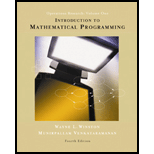
Concept explainers
a.
Feasible region:
A feasible region for an LPP is the set of all points that satisfies the constraints and non-negative restrictions of the corresponding LPP.
Mathematical model of the given LPP:
Subject to the constraints,
b.
Explanation of Solution
Determining feasible region:
Given point:
The points
c.
Explanation of Solution
Determining feasible region:
Given point:
d.
Explanation of Solution
Determining feasible region:
Given point:
The points
Want to see the full answer?
Check out a sample textbook solution
Chapter 3 Solutions
Introduction to mathematical programming
- Given the objective function 2x1+5x2 that needs to be maximized and the graphical solution shown below, what is the optimal value of the objective function? 420 20 [ [8] Answer: 45arrow_forward0 1 X process service period P1 7 29 P2 12 25 P3 2 5 2 fill in the gant chart below (until time 20) for the most feasible case (X, Y, or Z) 3 4 5 6 Y process service period P1 8 34 P2 35 90 P3 7 20 7 Z process service period P1 5 22 10 P2 3 P3 7 58 8 9 10 11 12 13 14 15 16 17 18 19 20arrow_forwardManually solve the following linear program (which could result from a production problem) following the simplex algorithm. Start from the obvious basic feasible solution of Xb = (X3, X4, X5 ) = (18, 4, 12). You may use excel to carry out calculations in simplex tableau if it helps, but please include all tableaus from all iterations in your submitted work. Maximize: 30 X1 + 50 X2 Subject to: 3X1 +5X2 +X3=18. X1 +X4 =4. 2X2 +X5 =12. X1, X2, X3, X4, X5 >= 0.arrow_forward
- What is the difference between feasible solution and optimal solution?arrow_forwardExplain the relationship between the Bellman equation and the principle of optimality in dynamic programming.arrow_forwardCalculate solving of the following 0/1 Knapsack Problem Dynamic Programming! n = 7; W = 10; (w1, w2, w3, w4, w5, w6, w7) = (5, 2, 3, 6, 4, 3, 2); (b1, b2, b3, b4, b5, b6, b7) = (36, 16, 21, 57, 28, 24, 13) n = 8; W = 9; (w1, w2, w3, w4, w5, w6, w7) = (5, 2, 3, 2, 6, 2, 4, 3); (b1, b2, b3, b4, b5, b6, b7) = (32, 59, 30, 17, 81, 16, 39, 25)arrow_forward
- Assume you want to run a computer program to derive the efficient frontier for your feasible set of stocks. What information must you input to the program?arrow_forwardA circus is planning a tower act in which individuals stand on top of one another's shoulders. Each individual must be both shorter and lighter than the person below him or her for practical and aesthetic reasons. Write a way to determine the maximum feasible number of people in such a tower given the heights and weights of each individual in the circus.arrow_forward8. A school is creating class schedules for its students. The students submit their requested courses and then a program will be designed to find the optimal schedule for all students. The school has determined that finding the absolute best schedule cannot be solved in a reasonablo time. Instead they have decided to use a simpler algorithm that produces a good but non-optimal schedule in a more reasonable amount of time. Which principle does this decision best demonstrate? O A Unreasonable algorithms may sometimes also be undecidable O B. Heuristics can be used to solve some problems for which no reasonable algorithm exsts O C. efficiency Two algorithms that solve the same problem must also have the same O B. Approximate solutions are often identical to optimal solutionsarrow_forward
- 8. A school is creating class schedules for its students. The students submit their requested courses and then a program will be designed to find the optimal schedule for all students. The school has determined that finding the absolute best schedule cannot be solved in a reasonable time. Instead they have decided to use a simpler algorithm that produces a good but non-optimal schedule in a more reasonable amount of time. Which principle does this decision best demonstrate? A. Unreasonable algorithms may sometimes also be undecidable B. Heuristics can be used to solve some problems for which no reasonable algorithm exists C. Two algorithms that solve the same problem must also have the same efficiency D. Approximate solutions are often identical to optimal solutions 0000arrow_forwardClear Solution plz.arrow_forwardRounding the solution of a linear programming problem to the nearest integer values provides a(n): a. integer solution that is optimal. b. integer solution that may be neither feasible nor optimal. c. feasible solution that is not necessarily optimal. d. infeasible solution.arrow_forward
 Operations Research : Applications and AlgorithmsComputer ScienceISBN:9780534380588Author:Wayne L. WinstonPublisher:Brooks Cole
Operations Research : Applications and AlgorithmsComputer ScienceISBN:9780534380588Author:Wayne L. WinstonPublisher:Brooks Cole
